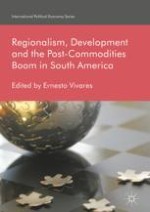2018 | OriginalPaper | Buchkapitel
5. The Changing Problem of Regional Development Finance in Latin America
verfasst von : Leonardo E. Stanley, José M. Fernández Alonso
Erschienen in: Regionalism, Development and the Post-Commodities Boom in South America
Aktivieren Sie unsere intelligente Suche, um passende Fachinhalte oder Patente zu finden.
Wählen Sie Textabschnitte aus um mit Künstlicher Intelligenz passenden Patente zu finden. powered by
Markieren Sie Textabschnitte, um KI-gestützt weitere passende Inhalte zu finden. powered by
